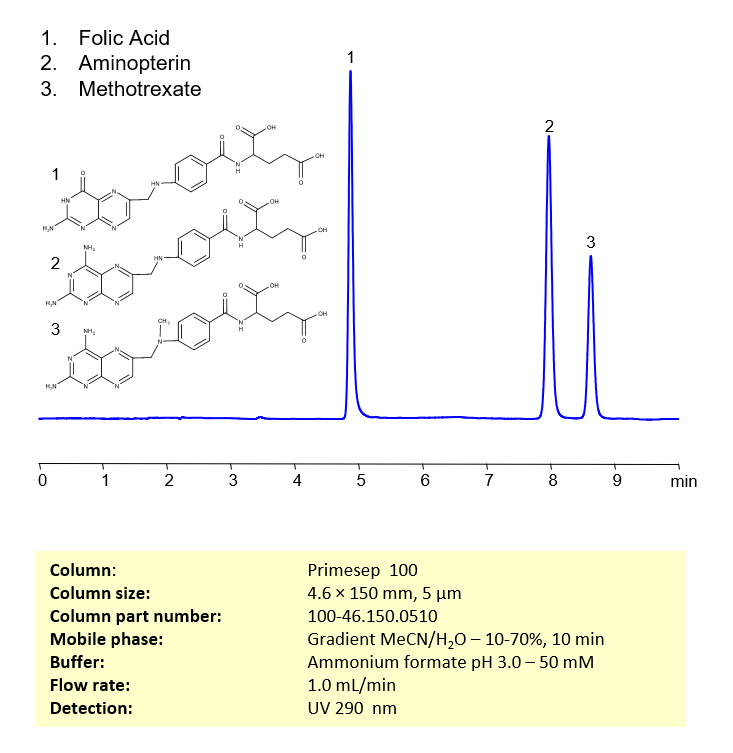HPLC Method for Separation of Methotrexate, Aminopterin, Folic Acid on Primesep 100 by SIELC Technologies
Separation type: Liquid Chromatography Mixed-mode
Aminopterin and folic acid are chemically related compounds that play significant roles in biochemistry and medicine.
Methotrexate, Aminopterin, and Folic Acid are chemically related compounds that have important roles in biochemistry and medicine.
- Methotrexate: This is a chemotherapy agent and immune system suppressant. Methotrexate is an antimetabolite and antifolate drug, meaning it inhibits the metabolism of folic acid. It does this by inhibiting the enzyme dihydrofolate reductase (DHFR), preventing the formation of active folate and thus interfering with DNA and RNA synthesis. It is used to treat certain types of cancer and autoimmune diseases like rheumatoid arthritis and psoriasis.
- Aminopterin: This is also an antifolate, and it works in a similar way to methotrexate, by inhibiting the enzyme DHFR. Aminopterin was one of the first antifolates to be used in cancer chemotherapy. However, it has largely been replaced by methotrexate, which is less toxic and more effective.
- Folic Acid: Also known as folate or vitamin B9, this is an essential nutrient that the body needs for many functions. It’s critical for the synthesis, repair, and functioning of DNA, as well as for cell division and growth. A deficiency of folic acid can lead to anemia and other health problems.
The antifolate drugs methotrexate and aminopterin are designed to interfere with the actions of folic acid, making them effective in slowing down the growth of rapidly dividing cells, such as cancer cells. However, this can also affect normal, healthy cells, leading to side effects.
Aminopterin, methotrexate and folic acid can be retained, separated, and analyzed using a reverse-phase Primesep 100, 4.6 x 150 mm, 5 µm, 100 A, dual ended column. The mobile phase for this method consists of water, acetonitrile (MeCN), and ammonium formate, which serves as a buffer. This analytical method can be monitored using UV detection at 290 nm, an Evaporative Light Scattering Detector (ELSD), or any other evaporative detection method such as Charged Aerosol Detection (CAD) or Electrospray Ionization Mass Spectrometry (ESI-MS)
LOD was determined for this combination of instrument, method, and analyte, and it can vary from one laboratory to another even when the same general type of analysis is being performed.
High Performance Liquid Chromatography (HPLC) Method for Analysis of Methotrexate, Aminopterin, Folic Acid
Condition
| Column | Primesep 100, 4.6 x 150 mm, 5 µm, 100 A, dual ended |
| Mobile Phase | Gradient MeCN -10-70%, 10 min |
| Buffer | Ammonium formate pH 3.0 – 50 mM |
| Flow Rate | 1.0 ml/min |
| Detection | UV 290 nm |
| Peak Retention Time | 5.08 min, 8.32 min |
| Sample concentration | 0.02 mg/ml |
| Injection volume | 5 µl |
| Sample diluent | H2O+NaOH |
| LOD | 0.04 ppm |
Description
| Class of Compounds | Drug, Aminopterin, Antifolates, Acid |
| Analyzing Compounds | Methotrexate, Aminopterin, Folic Acid |
Application Column
Primesep 100
Column Diameter: 4.6 mm
Column Length: 150 mm
Particle Size: 5 µm
Pore Size: 100 A
Column options: dual ended
Folic Acid
Methotrexate






